Review: Samsung Focus 2 for AT&T
May 23, 2012, 9:46 AM by Eric M. Zeman
The Samsung Focus 2 aims for the middle of the smartphone market and hits the target with ease. This smaller Windows Phone device boasts 4G LTE, a 5-megapixel camera, and solid performance. Is anything holding it back?
Form
Is It Your Type?
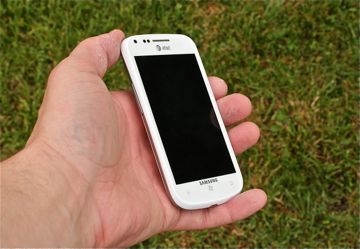
For the more conservative smartphone shopper who doesn't need the biggest and best, but still wants performance and power, the Samsung Focus 2 fills a good niche. It's not an entry-level smartphone, but not a flagship model, either. It comfortably offers plenty of features in a svelte design that few can scoff at.
Body
The Samsung Focus 2 is available from AT&T in white. The design harkens back to 2010-era smartphone looks with rounded corners and a smallish overall size. The white colors used in the outer shell practically glow, they're so clean and snowy. The white is broken up by a silver band that wraps around portions of the outside edge. It looks good, though perhaps a bit simplistic compared to the sleek appearance of higher-end devices.
The Focus has an interesting feel to it; it has to be made of the slipperiest plastics known to man. I can't tell you how many times I dropped this phone. The materials are smooth and glossy; so much so that the Focus is difficult to hold onto. The one benefit to the greased-up feel of the Focus is that it slips into even the tightest pockets without a hitch.
The wet-soap effect aside, the Focus is dense and solid, and the quality of the assembled device is top-notch. The seams are all tight, and the phone feels strong enough to take some serious punishment. I wouldn't use it to hammer in a nail, but it easily survived the dozen or so drops during my review period.
The front face of the phone is only about 80% screen. There are generous amounts of bezel above and below the screen. Above, the user-facing camera and sensors are plainly visible, and the earpiece is covered by a classy silver strip. Below, three capacitive buttons make up the standard Windows Phone controls. These buttons are easy to access and use, though they are too quick to turn off the illumination. When they are on, they are perhaps the brightest capacitive buttons I've ever seen. The entire front surface has a small lip that rims the outer edge. This protects the glass of the display when the Focus is placed on a flat surface. The lip isn't as intrusive as it is on other devices (such as the Lumia 900).
The only control on the left side of the Focus is the volume toggle. It has a good shape to it and is easy to find, but the action is cheap and unsatisfying. The power/lock button and dedicated camera button are both on the right edge of the phone. The power/lock button is nearly flush with the surface, but can still be found without trouble. Travel and feedback is good. The camera button is a two-stage button that has well-defined stages.
The 3.5mm headset jack is on the top of the Focus, and the microUSB port is on the bottom. The battery can be removed (a feature that's been disappearing from phones of late), and the microSIM card can be pulled once the battery is out. MicroSIM cards are used in a few devices such as the iPhone 4/4S, HTC One X, and Nokia Lumia 900, but not most GSM cell phones. Granted, this won't ever be a big deal to most people, but it's worth knowing before you buy the Focus.
The Three S's
Screen
The Focus 2's display measures 4.0 inches across the diagonal and sticks with the standard Windows Phone resolution of 800 x 480. Samsung used OLED technology in the display, and - thanks to the resolution and size - it looks fantastic. Colors are rich, blacks are inky, and the amount of light coming from the display is enough to dazzle your eyes. The high brightness lets the display be read easily outdoors under even harsh sunlight. It's a good screen, and one of the better ones I've seen on a Windows Phone.
Signal
The Focus is the latest LTE-capable phone to hit AT&T's network. When LTE isn't available, it ramps down to HSPA+. The device performed well no matter where I took it. I was able to make phone calls, which consistently connected on the first dial, even in a crowded concert venue. The Focus never dropped a call, nor did it miss any during my review period. Data speeds were always quick, even if the phone showed a single bar of signal.
Sound
I found the Focus to be an excellent voice phone. Most often, calls were crystal clear and free of noise and other network-related nonsense. The earpiece speaker produces very good volume for most environments. Only in the noisiest places might you have to crank it all the way up and press it firmly against your ear. Most often, it does well set at about 60%. The speakerphone also sounded excellent. Voices were warm and clear coming through the speaker, though the volume of the speaker was a bit shy of great. The same volume issue affected ringers and alert tones, which I felt should have been louder when the phone was turned all the way up. The vibrate alert was strong enough to alert me to calls/messages even at a loud rock concert.
Battery
Battery life will depend on what sort of coverage you have available. Under HSPA+ coverage only, the Focus powered through a full waking day with no problem. It lasted from 7AM to 11PM consistently with charge to spare. Under LTE 4G coverage, however, the battery drains noticeably faster. In my tests, I saw the battery life drop from 100% to 29% in the span of about 5 hours with moderate to heavy use (taking photos, tweeting photos, checking email and RSS, etc.). Worse, there's no switch or other way to control the LTE radio. It's always on.
Basics
Menus
The Focus runs Windows Phone 7.5 Mango and, because of Microsoft's rules, hasn't been altered a bit by Samsung. The user interface and menu structure is the same as every other Windows Phone that is available on the market. This can be good or bad, depending on your point of view.
The lock screen includes only the most basic notifications, including calendar alerts, and missed call and unread email/text message counts. The lock screen doesn't offer previews of - nor shortcuts to - those messages.
The single home screen is littered with Live Tiles, which can be moved about and arranged in any way that you wish. You can also choose to pin shortcuts or other actions to the home screen, where they'll reside in two columns of tiles. The main app menu is a single swipe from the home screen, and this is where all of the apps on the device are located. They're arranged in an alphabetical list and can't be moved around or otherwise rearranged.
The settings menu is buried in the main app menu, and lets you adjust the behaviors of the Focus in a limited way. It is broken into two categories: one for system-level adjustments, and another for application-level adjustments.
Microsoft's Metro UI, which Windows Phone is based on, has its pros and cons. It's fast and simple, with the trade-off of being somewhat rigid.
On the performance front, the Focus is no slouch. It may have only a single-core processor under the hood, but it's fast enough to handle all the needs of Windows Phone and the Focus.
Calls/Contacts
Telephony tools on the Focus - as on all Windows Phones - are easy to manage. The phone is just another app accessed from the home screen. The dial-pad itself is one of my favorites on any touch-based phone thanks to the huge software buttons.
The call history, contact search, and People Hub combine to make sure finding people to contact is a cinch. The People Hub, in particular, is a really interesting and rich way to approach the idea of a contact app. The Hub ties together your native contact lists with Facebook and LinkedIn accounts to provide an informative and interactive way to poke through the details of your family, friends, and coworkers.
I particularly like how the People Hub shows you information about those with whom you've recently interacted and their most recent status updates.
Messaging
Messaging tools on Windows Phone devices are in line with those offered by competing platforms. That means you get a solid email client, text/IM messaging, and some built-in social networking features.
I am fond of the email app, which handles any type of email service, including Exchange, POP3, and IMAP4, with ease. It's easy to merge all of your inboxes into a linked account, or leave them as separate inboxes on the Focus's home screen. The Metro UI treatment of the email app makes it easy to see unread, flagged, and urgent emails with quick swipes to the left.
The SMS app and IM app are one in the same, and handle text messages and Windows Live instant messages from a single user interface. I don't find it quite as visually appealing as the SMS apps offered by iOS or Android, but it still offers threaded conversations and stuffs media inline with the text.
The People Hub syncs with Facebook, Twitter, and LinkedIn, so there's some serious social networking added to the core Windows Phone experience. The integration with the People Hub means you have access to recent tweets, status updates, and photos, but the Hub lacks the full power of the native applications for these services. The Facebook app for Windows Phone is decent; the LinkedIn app is acceptable; but the Twitter app is horrid. Seek out a third-party app if you're a power Twitter user.
Extras
Media
Zune
The Zune Music Store and media player are the default clients on any Windows Phone for consuming music and video content. The Zune store can be used to purchase content as well as serve as a source of info for the content you've sideloaded yourself. It relies heavily on the Metro UI concept and requires a lot of swiping back and forth to successfully navigate.
The music and video playback tools are decent and work with DRM-free stuff. If you've got any content that has DRM attached (like movies downloaded from iTunes), it won't work.
You can hit up the Marketplace to download other music apps/services, such as Slacker, Vevo, and Pandora. Once you do, they'll be recognized by the Zune software and added as options in the Zune Hub. That means you can access all your media from one place, rather than digging through the app menu to find all the different music apps.
Music sounded great through my favorite headphones, and HD video content looked nice on the Focus's display.
U-Verse
The only AT&T-branded media app on board is its U-Verse Mobile app. This app lets subscribers of AT&T's home service access and use some of the features of the home DVR, and so on.
Camera
Camera
The Focus's 5-megapixel camera operates just as the cameras on other Windows Phone devices. The camera can be opened at any time with a long press to the camera button, even when the phone is locked or in the middle of using another app.
There is a box that appears in the center of the screen to help with centering the shot. Basic controls to access zoom and the video camera are stacked on right side of the display. The Focus offers a lot of tools for controlling the camera, including shooting modes, face detection, smile detection, scenes, burst shot, and of course control over the flash.
One feature I liked is touch-to-focus. It works very quickly, and will focus on whatever object you select in the viewfinder. Once it focuses, it shoots the picture without requiring users to also press the shutter button. The physical camera key is great thanks to the really well-defined two-stage control.
Once images are captured, they are whisked into the gallery app. The right edge of the previous photo serves as the frame on the left side of the viewfinder. It's a quick reminder of what it is that you've most recently shot, and swiping it provides quick access to the gallery.
Pictures Hub
The Pictures Hub is all about the community experience. It lets you easily upload images to Facebook, SkyDrive (Microsoft's photo upload service), Flickr, or send them along via MMS or email. Microsoft wants users of Windows Phones to spread the photo lovin'.
The native gallery app doesn't have any editing tools other than using the "auto-enhancer" setting. All this does is fix exposure, white balance, color, etc. You can't crop or rotate, and you have no control over how the auto-enhancer works. It does its thing, and you either have to take it or leave it.
Thankfully, the Focus includes the same Photo Studio application from Samsung that has appeared on other WP7 phones. This separate app is a rich photo editor with a vast set of features that include crop, rotate, fix brightness, fix contrast, fix color, etc. It works with the pictures you've taken with the Focus itself, but not those in your Facebook folder (it will share directly to Facebook, Picasa, and other web services, though).
Even more interesting, the Photo Studio software can act as a camera and lets you apply a lot of effects to shots as you take them. For example, you can pick panorama mode for wide vistas, or “plus:me” to add yourself to existing photos, and so on. It's a neat tool that bolsters the Focus's otherwise stock camera.
Photos/Video
Photos
The Focus has a 5-megapixel camera and the images I captured with it were all quite good. I saw accurate color, sharp focus, and crisp, clear results. There's little grain and some of the images really showed great detail. I took the Focus to a concert and managed to capture some exceptional photos with it. Concerts are extremely challenging for even the best cameras thanks to the tricky lighting. The fact that I was able to get images with even a modicum of detail that weren't completely over- or underexposed is a testament to how well the Focus's camera sensor was designed.
The Focus has a really good fire-and-forget camera that you don't need to adjust much to get good pix.
Video
The Focus captures video in up to 720p HD resolution. I found the video captured was quite excellent. The videos didn't have any of the over-sharp and jittery problems I've seen on superior devices. Instead, video was accurately exposed, in focus, and colors looked rich and warm. I wish the video camera had more options, though, especially the ability to capture video in 1080p HD.
Browse/Customize
Browser
Internet Explorer on Windows Phone devices is decent. Both mobile and full HTML sites look really good on the Focus' display, and Internet Explorer was good at rendering pages quickly. Browsing speeds were consistently good: the browser did the best it could with whatever signal was available and the results always impressed me. The browser supports the standard list of features for a smartphone, including pinch-to-zoom, double-tapping to zoom, multiple tabs, etc.
Customize
Windows Phone 7.5 Mango offers few customization tools. Users can recolor, rearrange, delete, and otherwise organize how the Live Tiles behave on the home screen. But that's about it. The main menu is stuck in the list view, which gets kind of old if you install a lot of apps. Being able to pin apps, shortcuts, web pages, etc., to the home screen as Live Tiles is cool. Beyond these simple controls, however, the Windows Phone interface remains relatively locked down. It would be nice to see even the color palette for icon/background colors changed up a bit.
Extras
Apps
The Focus doesn't have too many apps preloaded. AT&T has preloaded a minimal set of its branded apps on the handset (MyATT, Code Scanner, FamilyMap, and Navigator). There's very little bloat. The Marketplace for Mobile is a pleasant place to browse for apps, which are plentiful enough to make up for the lack of apps pre-installed on the Focus.
Bluetooth
The Focus's Bluetooth radio worked as it is supposed to. I had no trouble pairing with any device. Phone calls via mono Bluetooth headset sounded excellent, as did calls sent to my car speakers. Music pushed through stereo headphones was also good.
Clock
Most smartphones these days offer a white, digital clock of some sort on the lock screen. The Focus does this, too. It is a bit too small, if you ask me, and isn't as noticeable as the date is (which I usually don't care that much about). I wish there were a way to control the clock on the lock screen. There isn't. It suffices, but just barely.
Maps
The Focus uses Microsoft's Bing Maps. The feature set is the same as most other free mapping services, and it offers a rich user interface and step-by-step directions. The Focus also has AT&T Navigator, which works very well, but costs $10 per month to use. It's a shame the Focus doesn't (yet) have access to Nokia's incredible mapping and location apps; they;re far superior to Bing Maps.
Office
As with all Windows Phone devices, the Focus syncs well with Microsoft-based work and productivity tools. The versions of MS Word, Excel and PowerPoint that are in the Office Hub sync perfectly back and forth with the desktop versions. Users can save files to their personal SkyDrive for access later or from PCs. The Office Hub also lets people share documents and files if using the Focus on a corporate network.
Wrap-Up
The Samsung Focus 2 isn't perfect, but it's not far off the mark, either. My biggest gripe with the handset is its slippery plastic shell. Yes, it really is that easy to drop. Otherwise, it earns solid A's across the board.
The display looks great, the phone latches onto AT&T's network firmly, voice calls sound great, and the battery lasts all day under HSPA+ coverage. The user interface isn't perfect, but it performs speedily and without trouble. The camera and video camera are both impressive and the PhotoStudio software from Samsung really lets creative types enhance their content.
Not in the market for a $200 or $300 high-end super phone? Don't like massive displays and huge, heavy phones? For the price ($50 on contract), the real-deal Samsung Focus 2 is a steal.

Comments
No messages


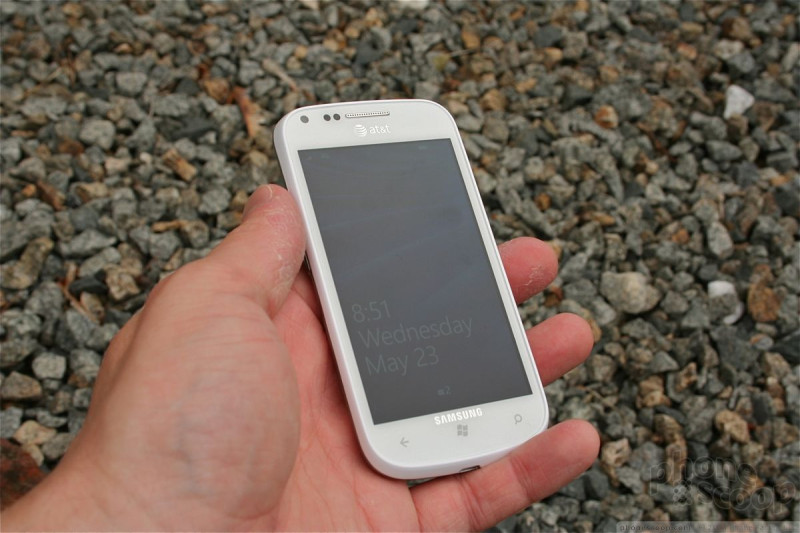








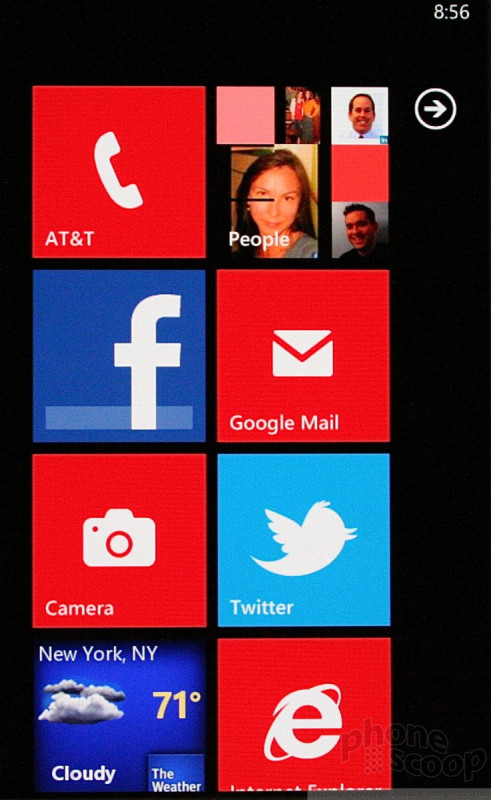





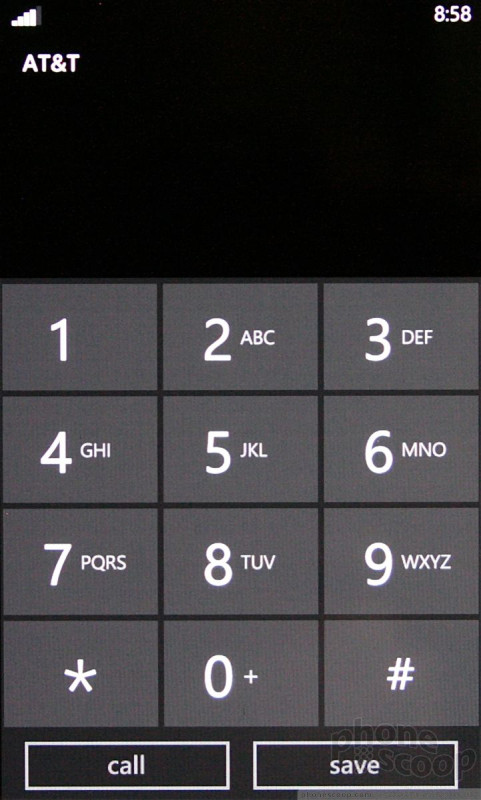





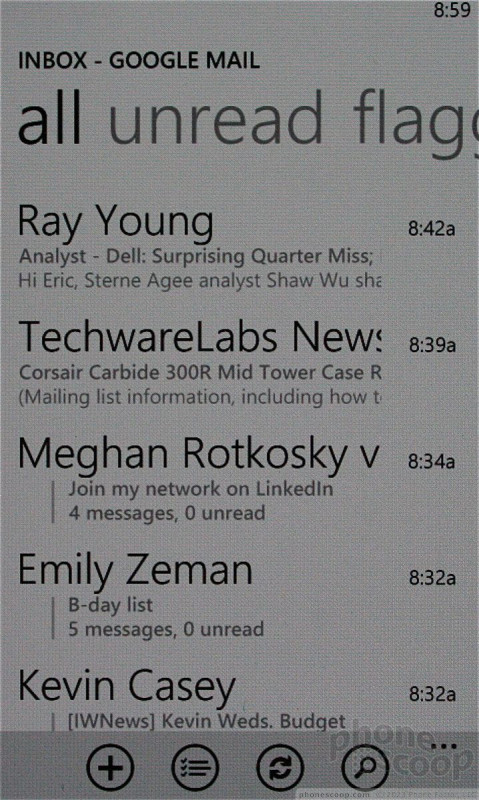








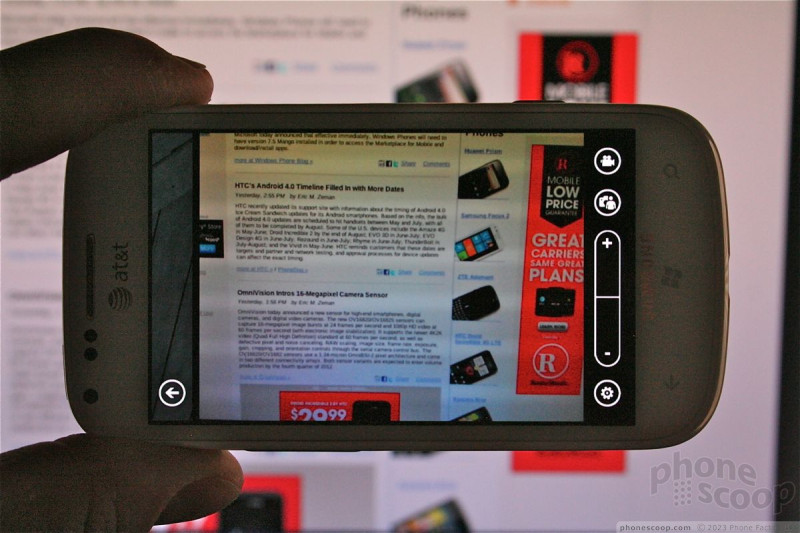




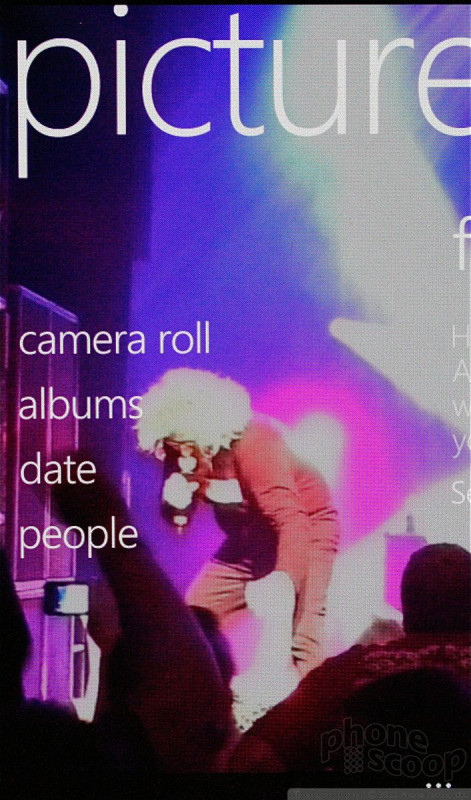



















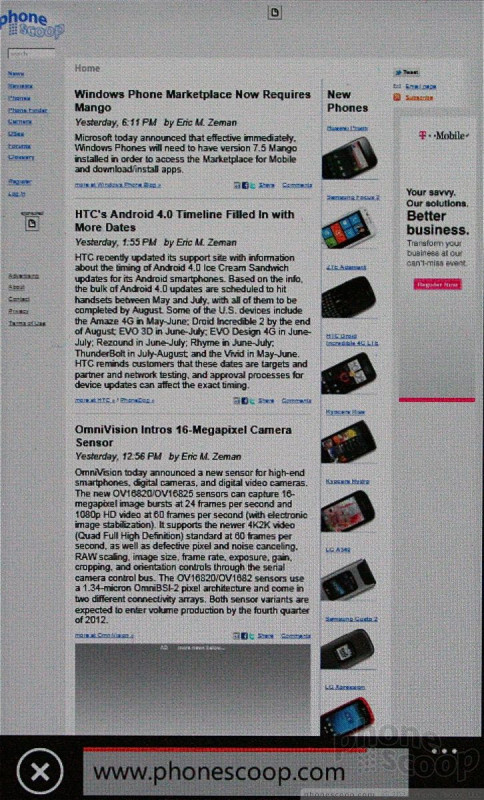




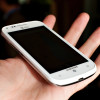 Hands-On: Samsung Focus 2
Hands-On: Samsung Focus 2
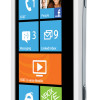 AT&T Boosts LTE Portfolio with Samsung Focus 2
AT&T Boosts LTE Portfolio with Samsung Focus 2
 iPhone 15 Series Goes All-In on USB-C and Dynamic Island
iPhone 15 Series Goes All-In on USB-C and Dynamic Island
 Samsung S24 Series Adds More AI, Updates the Hardware
Samsung S24 Series Adds More AI, Updates the Hardware
 iPhone 16 Brings More Features to All Price Points, Including New Camera Control
iPhone 16 Brings More Features to All Price Points, Including New Camera Control
 Samsung Focus 2
Samsung Focus 2




